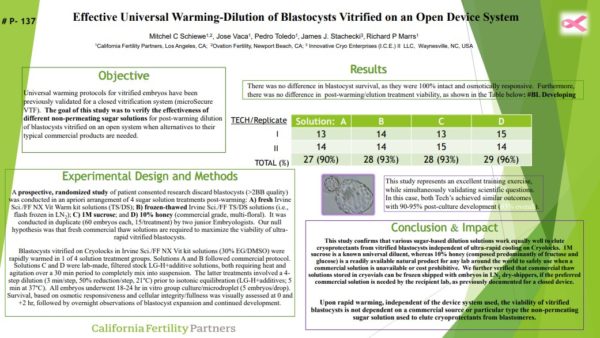Authors: M.C. Schiewe1,2 J. Vaca1; P. Toledo1; J.J. Stachecki3 R.P. Marrs1
Objective: Universal warming protocols for vitrified embryos have been previously validated in our lab for a closed system. The goal of this study was to verify the effectiveness of different non-permeating sugar solutions for post-warming dilution of blastocysts vitrified on an open system when alternatives to their typical commercial products are needed. A prospective, randomized study of patient consented research discard blastocysts (>2BB quality) was conducted in an apriori arrangement of 4 sugar solution treatments post-warming: A) fresh Irvine Sci./FF Vit Warm kit solutions (TS/DS); B) frozen-thawed Irvine Sci./FF TS/DS solutions (i.e., flash frozen in LN2); C) 1M sucrose; and D) 10% honey (commercial grade, multi-floral). Our null hypothesis was that fresh commercial thaw solutions are required to maximize the viability of ultra-rapid vitrified blastocysts.
Materials and Methods: Blastocysts vitrified on Cryolocks in Irvine Sci./FF NX Vit kit solutions (30% EG/DMSO) were rapidly warmed in 1 of 4 solution treatment groups. This training study included 30 blastocysts per group accounting evenly for quality and batch effects before randomly assigning the treatment. Solutions A and B were commercial IS/FF products (TS/DS)/methodology, whereas C and D were lab-made, filtered stock LG-H+additive solutions (1M sucrose w/v and 10% honey v/v, respectively). The latter solutions both required heating and agitation over a 30 min period to completely mix into suspension. These treatments (C and D) involved a 4-step dilution (3 min/step, 50% reduction/step, 21°C) prior to isotonic equilibration (LG-H+additives; 5 min at 37°C), followed by 18-24 hr in vitro group culture/microdroplet (5 embryos/drop). Survival, based on osmotic responsiveness and cellular integrity/fullness was visually assessed at 0 and +2 hr, followed by overnight blastocyst expansion and continued development.
Results: There was no difference in blastocyst survival (100%) or in-vitro development (90-96%) between treatments (A: 27/30, 90%; B: 28/30, 93%; C: 28/30, 93%; D: 29/30, 96%).
Conclusions: This study confirms that various sugar-based dilution solutions work equally well to elute cryoprotectants from vitrified blastocysts independent of ultra-rapid cooling on Cryolocks. 1M sucrose is a known universal diluent, whereas 10% honey (composed predominantly of fructose and glucose) is a readily available natural product for any lab around the world to safely use when a commercial solution is unavailable or cost prohibitive. We further verified that commercial thaw solutions stored in cryovials can be frozen shipped with embryos in LN2 dry-shippers, if the preferred commercial solution is needed by the recipient lab.
Impact Statement: Upon rapid warming, independent of the device system used, the viability of vitrified blastocysts is not dependent on a commercial source or particular type the non-permeating sugar solution to elute cryoprotectants from blastomeres.
Disclosures: JJS is the owner of I.C.E. II, LLC and MCS is one of his scientific advisors.
